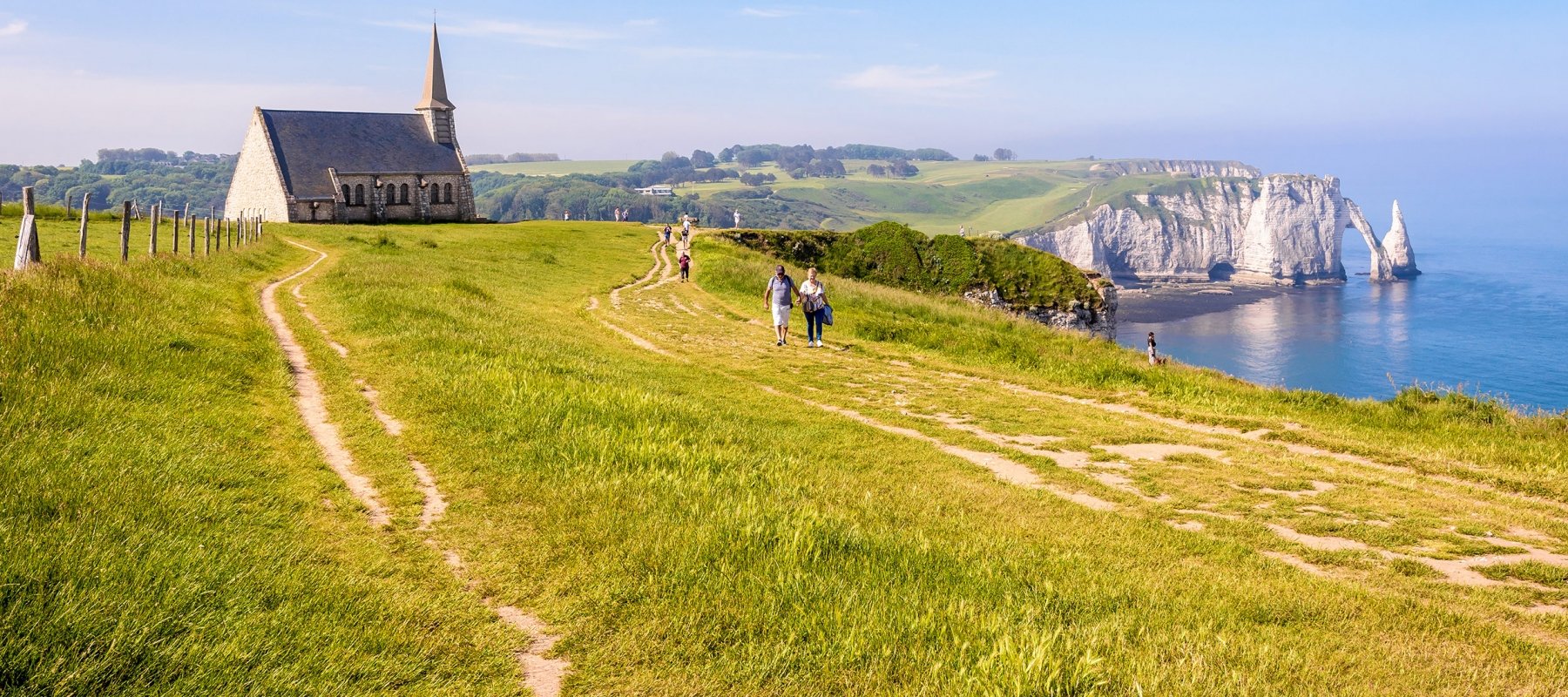Sitting on a bench at Normandy’s American Cemetery, Tasha Bouvier felt a profound sense of family connection. “After our guided tour, we had maybe 20 minutes to do whatever we wanted,” recalls Tasha of that sunny October afternoon on the coast of France. “There were these little benches and I just kind of sat and took it all in. It boggles my mind that my grandfather served in World War II. I never really got to know him, but I felt like he was there with me—experiencing it together.” In October 2023, Tasha joined the Country Walkers France: Normandy & Brittany Guided Tour—for the incredible walks, the stunning views, and family remembrance. “My initial reason for booking this trip was to experience Omaha Beach,” says Tasha. “My grandfather served as a World War II bomber pilot—and although I never got to talk to him about his experience, I heard about it secondhand from my uncles and aunts.” For Tasha, and many Country Walkers guests, experiencing the American Cemetery is an important act of family commemoration—honoring World War II veterans and their gallant sacrifice.
A Seaside Steeped in Sunshine and Remembrance
Walking along the sandy shores from the coast of Arromanches to Omaha Beach, it’s hard to envision the epic battle that took place here. This seaside resort town is all sweetness and light—with couples on horseback chasing azure waves across smooth sand beaches, and local fishermen shucking oysters on the shore for a quick quayside snack. “It might feel like a surprise, to see people swimming or playing on Omaha Beach,” observes local Normandy historian Guillaume Marie. “But this is what the American veterans fought for. When I was young, the American veterans would say—we fought for freedom so that people can enjoy the beach and the beautiful weather.” Strolling along the miles of peach-colored sand, sunny skies, and calm azure waters of this scenic coastal area is, for some, an act of sacred commemoration—dedicated to the soldiers who fought to preserve the natural beauty of the French coast for generations to come.
As people mingle together to enjoy the sunny Norman shores, remembrance of the epic battle is never far off. “It’s about a mile walk along the sandy beach,” recalls Tasha. “And along the way, we were literally standing on the shores where ships were fighting and the bombs were falling. It was kind of strange to think almost 80 years ago, this was all happening and to look around now, you’d never know it.” As Tasha and her group explored the beach, they enjoyed a guided tour of the old German bunkers and monuments that commemorate the historic battle. “At 4:00 p.m., we got to see the flag ceremony. They raise the flag and there’s a ceremony with soldiers marching in uniform. When they lower the flag, they fold it into its ceremonial triangle and the bugle plays taps. It’s a very moving experience.” Visitors who have a family member who fell during the Battle of Normandy in 1944 can also reach out to the American Battle Monuments Commission to arrange an escort to the gravesite, and a private ceremony to honor their sacrifice.
Discovering Historic Brittany and Mont St. Michel
Northern France is steeped in historic traditions—and the coast of Normandy is in no way outdone by its close neighbor, Brittany. Medieval history buffs will be in their element as they walk the cobblestoned streets of seaside Saint Malo—an ancient walled city built on a sandy spit of land jutting into the English Channel. Here, a two-night stay in the waterfront Hôtel Le Nouveau Monde gives Country Walkers guests the perfect vantage point to enjoy this charming city—including upscale sea-view restaurants, luxurious spa with indoor pool and steam rooms, and on-site hammam and solarium. It’s the perfect place to discover the rich history of Brittany’s coast—and the legendary island of Mont St. Michel.
In ancient times, the monastery of nearby Avranches was a local center of religious life. As legend has it, early in the 8th century, Bishop Aubert of Avranches began to have a series of troubling dreams. While Aubert slept, the Archangel Michael appeared and commanded him to construct an elaborate monastery on a nearby tidal island of precipitous cliffs. Aubert thought the request somewhat unreasonable—and is said to have dismissed it as a side-effect of consuming too many oysters before bedtime. However, the dream reoccurred—and Aubert continued to equivocate. The third time the archangel visited the bishop, the angelic mood was decidedly stern. To emphasize his directive, the archangel tapped Aubert on the forehead with an angelic finger—burning a hole through the bishop’s skull. Upon waking, the indelible imprint of the angelic fingertip remained on his forehead—prompting Aubert to begin building the imposing monastery that has been capturing the imagination of viewers for centuries. Aubert was later canonized for his achievement.
During her visit to Mont St. Michel, Tasha was lucky enough to view the famous relic of Saint Aubert’s skull—complete with angelic imprint. “Mont St. Michel is incredible—it takes so many steps to climb all the way up and the views are amazing,” recalls Tasha. “But the really cool part was seeing the relic of Saint Aubert, which was temporarily on display. The skull was resting in a large gold-plated reliquary—and you can literally see the spot where the Archangel touched his skull.” A guided tour of this imposing historic monument rounds out an epic walking tour through the stunning coastal scenery, cuisine, and history of northern France.

